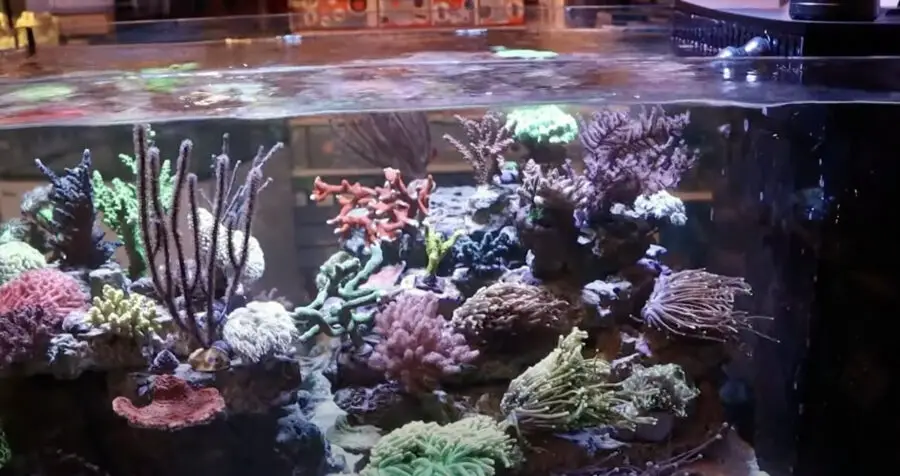Magnesium levels can be high for your tank, but you needn’t worry in most cases.
This article discusses this in detail to inform you about this exciting aquarium topic.
Why Is Magnesium High in Reef Tank
Magnesium has numerous functions in aquariums. For starters, corals and other organisms need it to break down calcium. Second, it interacts with aquarium water, making calcium dissolve more quickly in the water column.
Magnesium test kits, like calcium test kits, typically provide the magnesium level in parts per million (ppm). The magnesium content of natural seawater is 1285 ppm. Reef tanks require a level between 1250 and 1350 ppm, but magnesium values between 1200 and 1400 ppm are usually harmless.

Magnesium also helps maintain calcium and the alkalinity levels in the reef tank. Peradventure, if the levels of these minerals are low, the calcium will have to combine with the alkaline substrate for calcium carbonate to be made in the water.
Can Magnesium Be High In Fish Tank
Yes. Magnesium can get high in fish tanks. However, this doesn’t necessarily call for fear or worry. A low level of magnesium can lead to low alkalinity. The high magnesium level can help raise the alkalinity level in the fish tank.
Magnesium at 1400 ppm is high but not a concern. You may decide to do nothing about it. If tested correctly, it would probably reduce through water changes with lesser magnesium levels over time.
Ideal Magnesium Level In Fish Tank
All aquatic creatures and plants require magnesium and calcium; therefore, keeping magnesium levels similar to what saltwater fish are accustomed to in the wild is critical.
Many species are susceptible and can be severely harmed if the magnesium levels in the aquarium are too high.
A reef aquarium’s magnesium levels should be between 1200 and 1350 ppm. Because each aquarium is unique, it will consume magnesium at its own pace.
Low magnesium levels are usually not a concern for aquarists who keep fish-only tanks because this setup consumes the primary element slowly.
How To Lower Magnesium In Fish Tank
When you detect magnesium levels of 1400+ ppm, tank owners may consider lowering magnesium in reef tanks, although there is rarely cause for concern. Even levels as high as 1500 ppm are normally innocuous, but if you want to reduce it, a water change is your best chance.
A water change is significant when you want to reduce the magnesium level in the fish tank because when you carry out this change, the drained water will be released with some portion of the magnesium in the fish tank. Then the magnesium will be successfully reduced or lowered.
However, remember to use water with a reduced magnesium salt mix. When adding new water, utilize a blend with a lesser magnesium level.
Things will eventually balance out, and your magnesium content will stabilize. However, remember that this can take a long time, and some enthusiasts wind up for months before seeing a significant change.

Does High Magnesium Affect Corals
High magnesium does not affect corals. Magnesium is vital for the metabolic function of your tank corals, allowing them to grow strong and stay healthy throughout their lifetime.
Proper calcium and alkalinity levels in a coral tank are still considered more crucial than magnesium levels. However, some tank owners may be unaware that magnesium helps keep higher alkalinity and calcium levels in the aquarium without needing supplements.
Is Magnesium Important For Corals
Coral thrives on magnesium, and they certainly require it. Coral will grow robust and healthy as long as enough magnesium supports it.
Calcium and alkalinity work hand in hand, but their silent partners are magnesium. When the magnesium level in the fish tank is inadequate, calcium and alkalinity will come together and fall out of the solution.
Due to this, the two essential elements will become useless to the corals that are in the aquarium. This shows that these two elements will become unusable to the coral when magnesium is absent in the aquarium or is of a low level.
Magnesium is sometimes overlooked as a critical element, being overshadowed by others such as calcium and the tank’s alkalinity level. However, your coral will be fine if you maintain magnesium levels between 1280 and 1350 ppm.
Testing your tank regularly and keeping track of magnesium, alkalinity, and calcium amounts are critical for allowing your coral to develop and remain vital. Understanding when to adjust the water to raise or reduce the temperature is equally crucial.
Does Coralline Algae Use Magnesium
Coralline algae also contain a significant amount of magnesium, often more than 1% and up to 4.4% by weight. There are little data on coral skeletons in aquariums, although their magnesium concentration is unlikely to differ much from that of the same animals living in the ocean.
Interestingly, coralline algae that ordinarily integrate a considerable quantity of magnesium into their calcium carbonate deposits (>1% magnesium by volume) have been demonstrated to incorporate less magnesium when the magnesium level of the water is reduced.
The amount absorbed is related to the content of magnesium. As a result, the quantity of magnesium they eat in aquaria is determined by the magnesium level of the water. This impact is likely to be shared by other calcifying species.
Conclusion
You don’t need to bother about excess magnesium in your reef tank. However, when the level is too high, as this article directs, it helps to consider a move such as changing waters.
You can keep your corals in healthy shape, although they won’t feel inconvenient with a considerably high magnesium level.
Table of Contents
